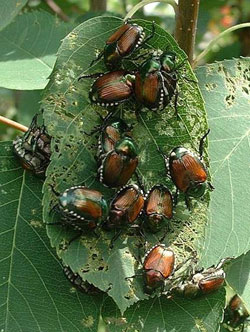
Just a few days ago, I saw the first Japanese beetles that have emerged so far this year in my landscape. A group of about six were chomping away on an azalea bush. Normally, I find them on my climbing hydrangeas and annual impatiens first. And not usually until closer to the Fourth of July weekend when the 90+ degree humid days have taken over.
Japanese beetles are a pretty insect from first glance. Iridescent green and brown, with sometimes almost purple colors on their bodies when basking in the sun. But their overall damage to the garden packs a punch. That’s why we gardeners detest the beetles!
It’s widely written that the female Japanese beetle will lay her eggs only in turf grass. Considering we have no “turf” in our backyard, I”m not sure that is really true. And, when I’m digging in non-turf areas of our property during the spring, fall and winter months, I find the Japanese beetle grubs all the time. The beetle spends most of its life underground as a grub. Check out the image of the Japanese beetle’s lifecycle courtesy of the University of Kentucky.

So how can we control the Japanese beetles? The beetle bag traps are popular and work well in my experience. I used the traps when I lived in a townhouse community with a postage-stamp-sized front yard. If you do use the traps, please be sure to empty the bags regularly or replace them. The beetles can be repelled by the scent of their decaying compatriots.
My personal “control” requires more effort on the part of the gardener. Each year, I fill an empty glass jelly jar a little over half full with rubbing alcohol. To catch the beetles, I just position the jar directly below the beetle(s), tap the beetles lightly with the lid, and they will fall directly into the jar. The alcohol suffocates them, and that is just fine with me. Sometimes a few will fly off if you’re not quick enough. I like to try to catch them in the mornings when they’re still a bit sleepy. Midday, they are usually pretty active and able to avert my capture attempts.
As an alternative to catching the beetles in a jar, I use a 12-month Bayer tree and shrub protector on my ornamentals such as boxwood, azaleas, and hydrangeas which seems to work well and is effective on other leaf-chewing insects. I’m not a huge fan of using insecticides so I try to use them only when there is no other option to save the plant.
My husband uses grub killers on our front lawn which seems to have lowered the beetle population over the years. We have not tried milky spore since the other treatment seems to be working at least in the lawn area. We had very few Japanese beetles on our property when we first moved here in the late 1990s. I’m wondering now if some of the beetles or their grubs hitched a ride with plants we’ve purchased and now incorporated into our landscape.
I don’t use the traps anymore. Our beetle population is still fairly small and I prefer they are not attracted to my plants for a snack as they mosey on down to the trap. I like the pick and dunk method with the rubbing alcohol jar. Using that jar also helps me to determine whether the population has grown or receded from the last year. I know it’s only a sampling, yet it helps me keep count. If you don’t have the time, an earth-friendly insecticide or one of the beetle traps should work for you.
For more information on Japanese beetles, check out the University of Kentucky’s entomology page.
Any other ideas you’d like to share about controlling the beetles? I’m all ears!

The japanese bettles are TERRIBLE in Ohio this year AND they are 2 weeks early. I tried the approaches you listed in your post several years ago. The nasty little things just kept coming! Then I tried an organic pesticide to no avail. Unfortunately I had to end up selective spraying with Sevin or Eight (:.
I have seen Japanese Beetles in pockets here in Virginia this year. They are feasting on a climbing hydrangea in the backyard that they never touched before — yet are not even touching the other climbing hydrangeas that they visited last year. We are removing the last bit of “turf” in our backyard to replace it with hardscape and maybe a fire pit.
It’s widely written that Japanese Beetle grubs only live/nosh under lawn turf. I don’t necessarily agree with the local gardening center that the Japanese Beetle grubs won’t eat my ornamental plants’ roots also. I collected into my alcohol jar about 50 of the beetles just on that one climbing hydrangea.